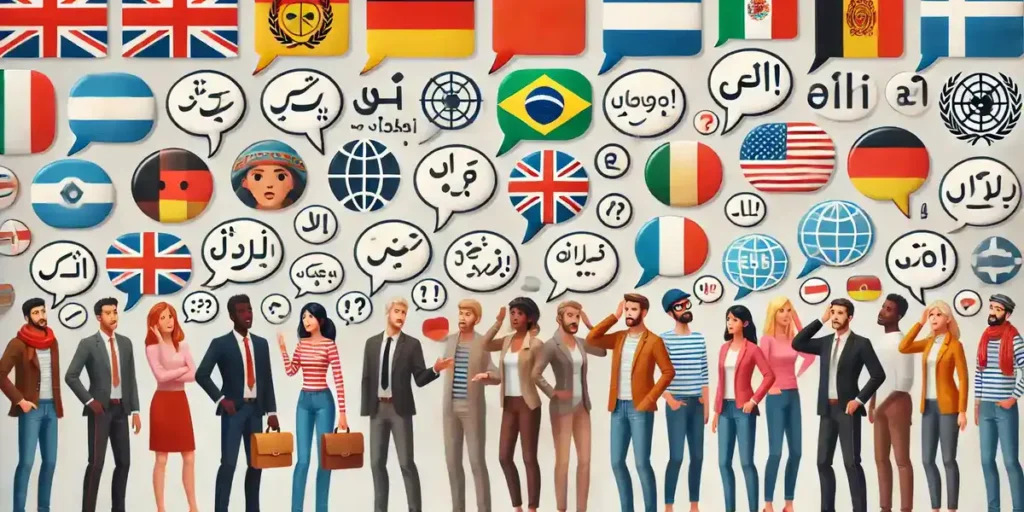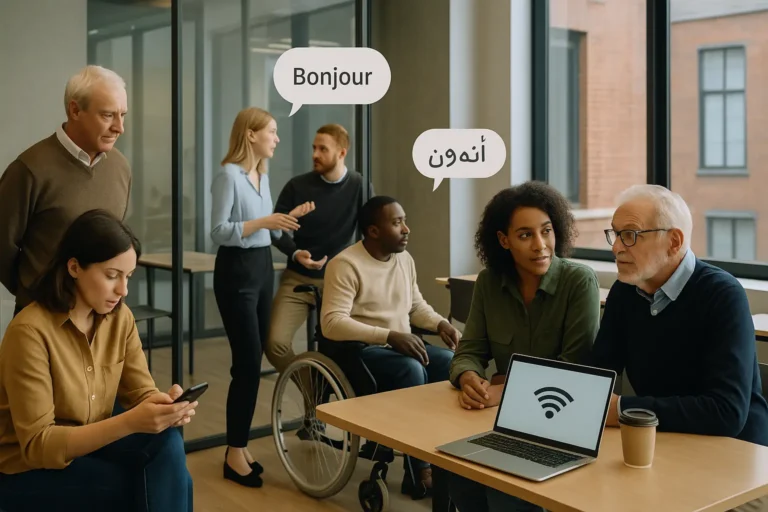Cross Cultural Barriers to Communication
Cultural differences often lead to communication breakdowns in teams. Such barriers can result in project delays, conflicts, and a stifled innovation environment, where the true potential of diverse teams remains untapped.
Cross-cultural barriers to communication include language differences, non-verbal misinterpretations, and cultural value conflicts, which can lead to misunderstandings and inefficiencies in multicultural teams.
Understanding and navigating these differences is essential for fostering clear and effective communication in diverse environments. This article explores the common cross-cultural barriers to communication and provides insights on how to overcome them for better understanding and collaboration.
What are Cross Cultural Barriers?
Cross-cultural communication involves exchanging information between individuals of different cultural backgrounds. It’s essential in our interconnected world as it fosters mutual understanding and cooperation. Effective communication reduces conflict, builds strong relationships, and opens opportunities in diverse settings.
Barriers of Cross-Cultural Communication
Barriers of cross-cultural communication encompass:
- Language Barriers: Differences in language, dialects, and idiomatic expressions can lead to misunderstandings.
- Cultural Norms and Values: Divergent views on hierarchy, collectivism vs. individualism, and etiquette can create friction.
- Non-Verbal Communication: Misinterpretation of gestures, eye contact, and personal space due to cultural differences.
- Perception and Stereotyping: Cultural stereotypes can bias communication and expectations, leading to prejudice or misjudgment.
- Time Perception: Varied attitudes towards punctuality and time management can affect scheduling and deadlines.
- Communication Style: Preference for direct vs. indirect communication can cause confusion or offense.
- Contextual Differences: High-context cultures rely on implicit communication while low-context cultures prefer explicit information, leading to miscommunication.
- Emotional Expression: Different norms around expressing or suppressing emotions can impact how messages are received.
- Ethnocentrism: Viewing one’s own culture as central to reality can prevent understanding of other cultural practices.
- Lack of Cultural Awareness: Without knowledge of other cultures, individuals might unintentionally offend or misunderstand.
These barriers can affect personal interactions, team dynamics, and organizational efficiency, emphasizing the need for cultural sensitivity training and adaptability in communication strategies.
cross cultural communication barriers examples
Here are some specific examples of cross-cultural communication barriers:
- Language Differences:
- Example: An English-speaking manager assumes everyone understands “ASAP” (as soon as possible), but a non-native English speaker might not know this acronym, leading to misunderstandings about deadlines.
- Non-Verbal Communication:
- Example: In some cultures, direct eye contact can be considered rude or confrontational, while in others it’s seen as a sign of honesty and respect. During a video conference, an American manager might perceive an Asian colleague’s lack of eye contact as a lack of confidence or sincerity.
- High vs. Low Context Communication:
- Example: A German executive (low-context culture) might be very direct in an email about work issues, which could be perceived as rude by a Japanese colleague (high-context culture), who is used to more indirect communication styles.
- Cultural Norms and Values:
- Example: During negotiations, a North American might value a contract as binding, while their Middle Eastern counterpart might view the relationship as more important than the written document, leading to different expectations about commitment and follow-through.
- Time Perception (Chronemics):
- Example: A project manager from a monochronic culture (like Germany) might find it challenging to work with a team from a polychronic culture (like many Latin American countries) where multiple tasks are often handled simultaneously, causing delays or perceived lack of urgency.
- Power Distance:
- Example: In a meeting, employees from a high power distance culture (e.g., Malaysia) might be hesitant to voice opinions or challenge decisions made by their superiors, which could be misinterpreted by a manager from a low power distance culture (e.g., Sweden) as a lack of initiative or engagement.
- Collectivism vs. Individualism:
- Example: An American individualist might promote a team member’s achievement, while in a collectivist setting like Japan, this could be seen as inappropriate, as it might disrupt group harmony or be perceived as self-promotion.
- Gestures and Body Language:
- Example: The “thumbs up” gesture, which is positive in many Western cultures, can be offensive in parts of the Middle East or West Africa.
- Emotional Expression:
- Example: A Latin American might use expressive body language and loud talking to show enthusiasm, which could be misconstrued as aggression by someone from a culture that values restraint, like Japan or Finland.
- Etiquette and Protocol:
- Example: In South Korea, giving and receiving business cards with both hands and a bow is a sign of respect. An American who casually offers their card might inadvertently show disrespect.
- Humor:
- Example: Humor doesn’t always translate well; British sarcasm or self-deprecation might not be understood or appreciated in cultures where directness is valued, like in Russia.
- Negotiation Styles:
- Example: Western negotiators might expect clear, logical arguments, while in many Eastern cultures, building a relationship and trust through prolonged discussion and indirect hints might be the norm before any business is discussed.
Understanding these examples helps in preparing for and navigating through cross-cultural communication, emphasizing the need for cultural sensitivity, active listening, and sometimes, the use of cultural mediators or trainers.

How can technology help or hinder cross-cultural communication?
Technology can both aid and impede cross-cultural communication in the following ways:
Helping Cross-Cultural Communication:
- Translation Tools: Apps and software that provide real-time translation can break down language barriers, allowing for clearer communication across different languages.
- Virtual Collaboration Platforms: Tools like Zoom, Microsoft Teams, or Slack facilitate communication across different time zones and locations, enabling people from various cultures to work together seamlessly.
- Cultural Sensitivity Training Online: E-learning platforms offer courses on cultural awareness and sensitivity, preparing individuals for cross-cultural interactions.
- Global Information Access: The internet provides resources for learning about different cultures, which can enhance understanding and empathy.
- AI and Machine Learning: These technologies can analyze communication patterns to suggest culturally appropriate responses or highlight potential misunderstandings.
- Social Media: Platforms can connect people globally, fostering cross-cultural exchanges and friendships, which can lead to greater cultural understanding.
- Accessibility: Technology can assist in communication for individuals with disabilities, ensuring that cultural communication is inclusive.
Hindering Cross-Cultural Communication:
- Loss of Non-Verbal Cues: Video calls or text-based communication often miss out on non-verbal signals like body language, tone, and facial expressions, which are crucial in understanding cultural nuances.
- Technological Disparities: Not all cultures or regions have equal access to the latest technology, creating a digital divide that can affect communication quality and frequency.
- Cultural Misinterpretations: Auto-translation tools are not perfect and can sometimes translate with errors that change the meaning, leading to misunderstandings.
- Information Overload: The sheer volume of information available can be overwhelming, making it difficult to filter what is relevant or culturally accurate.
- Lack of Context: Digital communication often lacks the rich context of in-person interactions, which can lead to miscommunications, especially in cultures where context is key.
- Cyber Misbehavior: Anonymity online can lead to cultural insensitivity or outright hostility, as individuals might feel less accountable for their actions or words.
- Echo Chambers: Social media algorithms can create echo chambers where individuals are exposed only to like-minded cultural perspectives, reducing cross-cultural empathy or understanding.
- Time Zone Challenges: While technology allows for global communication, coordinating across time zones can still lead to delays or missed opportunities for real-time dialogue.
To maximize the benefits and minimize the downsides, it’s crucial to:
- Use technology with an awareness of its limitations.
- Implement best practices for virtual meetings that consider cultural differences.
- Educate teams on the potential for miscommunication through digital mediums.
- Encourage the use of visual aids or emojis to express emotions or intent when words might fail.
- Promote digital etiquette that respects cultural differences.
By leveraging technology wisely, organizations and individuals can enhance cross-cultural communication, but they must also be vigilant about its potential to create or exacerbate barriers.
Strategies to Overcome Cross Cultural Barriers
Overcoming cross-cultural barriers requires strategic planning and dedicated initiatives. Implementing targeted approaches ensures smoother communication and fosters mutual understanding.
Cultural Awareness Training
Cultural awareness training is crucial for bridging communication gaps. Training educates employees about different cultural norms and communication styles. It helps them recognize potential barriers and equips them with tools to navigate cultural differences effectively.
Effective training programs include real-life scenarios, role-playing, and interactive workshops. They provide employees with practical experience in handling cross-cultural interactions. Companies may also incorporate e-learning modules to make the training more accessible.
Case studies show that companies with robust cultural awareness training see improvements in employee communication and collaboration.
Effective Use of Interpreters
Interpreters play a vital role in facilitating clear communication between parties speaking different languages. Their use ensures messages are accurately conveyed and understood. When deploying interpreters, it’s essential to select individuals proficient in both the source and target languages and familiar with relevant cultural contexts.

To maximize the effectiveness of interpreters:
- Briefing: Inform interpreters about the context and objectives of the interaction.
- Clear Communication: Encourage speakers to articulate their messages clearly and at a moderate pace.
- Feedback: Use feedback sessions to address any miscommunications and improve future interactions.
Utilizing interpreters properly can significantly reduce misunderstandings and build stronger, more effective communication channels across cultures.
Conclusion
Navigating cross-cultural barriers to communication requires a proactive approach and a commitment to continuous learning. By fostering cultural awareness and utilizing interpreters effectively, we can bridge gaps and enhance our interactions in diverse settings. It’s essential to recognize that successful communication in a multicultural environment isn’t just about language proficiency but also about understanding and respecting different cultural norms and behaviors. Investing in training programs and promoting an inclusive mindset will ultimately lead to better collaboration and improved business outcomes. Let’s embrace the diversity around us and work towards clearer, more effective communication across cultures.






